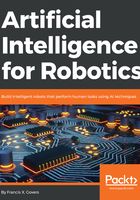
The basic principle of robotics and AI
Artificial intelligence applied to robotics development requires a different set of skills from you, the robot designer or developer. You may have made robots before. You probably have a quadcopter or a 3D printer (which is, in fact, a robot). The familiar world of Proportional Integral Derivative (PID) controllers, sensor loops, and state machines must give way to artificial neural networks, expert systems, genetic algorithms, and searching path planners. We want a robot that does not just react to its environment as a reflex action, but has goals and intent—and can learn and adapt to the environment. We want to solve problems that would be intractable or impossible otherwise.
What we are going to do in this book is introduce a problem – picking up toys in a playroom—that we will use as our example throughout the book as we learn a series of techniques for applying AI techniques to our robot. It is important to understand that in this book, the journey is far more important than the destination. At the end of the book, you should gain some important skills with broad applicability, not just learn how to pick up toys.
One of the difficult decisions I had to make about writing this book was deciding if this is an AI book about robotics or a robotics approach to AI—that is, is the focus learning about robotics or learning about AI? The answer is that this is a book about how to apply AI tools to robotics problems, and thus is primarily an AI book using robotics as an example. The tools and techniques learned will have applicability even if you don’t do robotics, but just apply AI to decision making to trade on the stock market.
What we are going to do is first provide some tools and background to match the infrastructure that was used to develop the examples in the book. This is both to provide an even playing field and to not assume any knowledge on the reader’s part. We will use the Python programming language, the ROS for our data infrastructure, and be running under the Linux operating system. I developed the examples in the book with Oracle’s VirtualBox software running Ubuntu Linux in a virtual machine on a Windows Vista computer. Our robot hardware will be a Raspberry Pi 3 as the robot’s on-board brain, and an Arduino Mega2560 as the hardware interface microcontroller.
In the rest of this chapter, we will discuss some basics about AI, and then proceed to develop two important tools that we will use in all of the examples in the rest of the book. We will introduce the concept of soft real-time control, and then provide a framework, or model, for interfacing AI to our robot called the Observe-Orient-Decide-Act (OODA) loop.